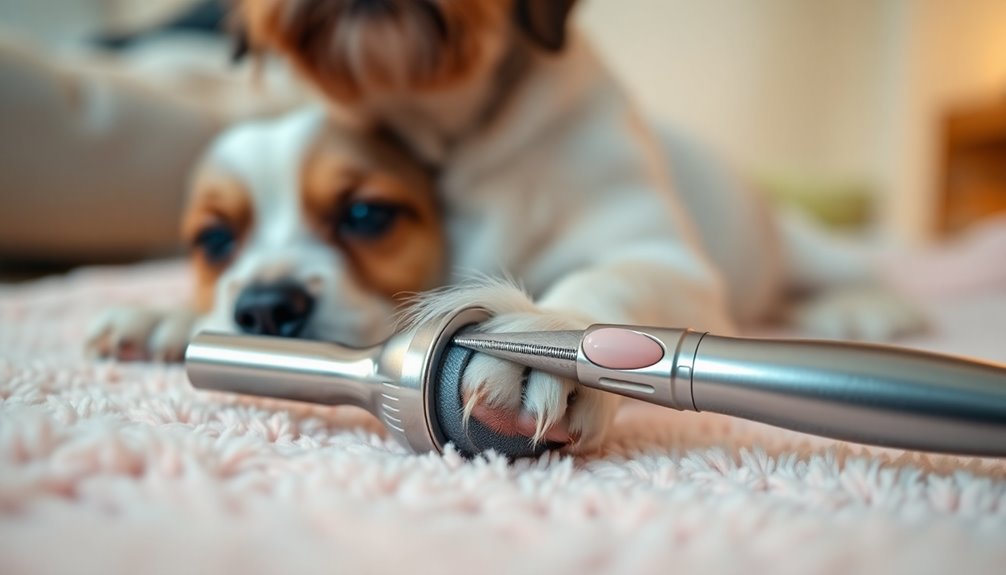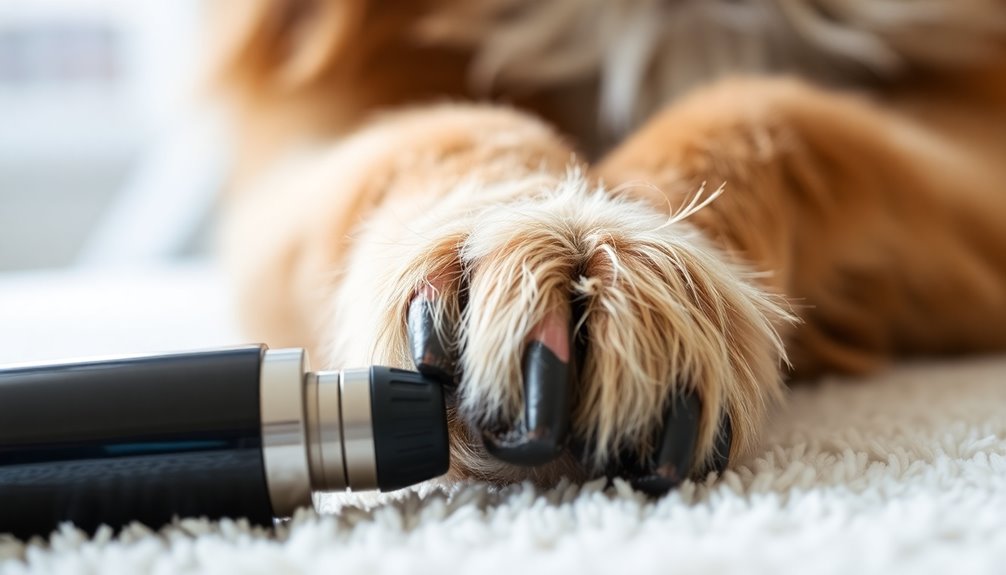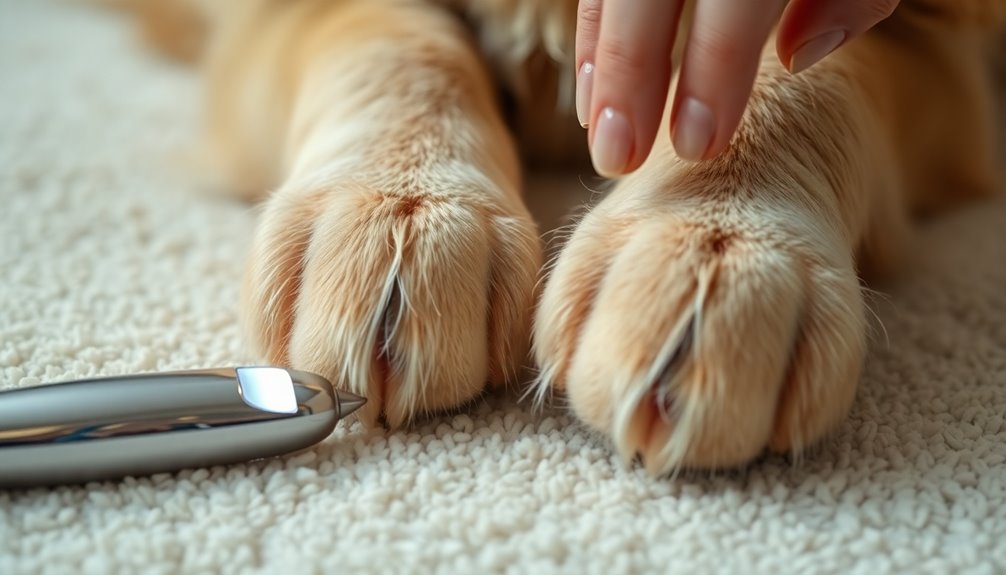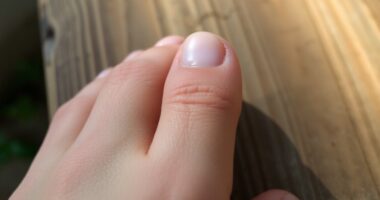To grind your dog's nails, first choose a suitable grinder for their size and nail type. Calmly introduce your dog to the grinder's sound and use gentle techniques for a safe experience. Opt for low-noise grinders to ease anxiety, and grind every 2-4 weeks, depending on activity levels. Reward your dog with treats and praise throughout to create a positive experience. Want to learn more tips for successful nail grinding? Keep going!
Key Takeaways
- Choose a grinder suitable for your dog's size and nail type to ensure effective trimming.
- Introduce the grinder in a calm environment, allowing the dog to acclimate to its sound.
- Use a gentle technique and low-noise settings to minimize stress during the grinding process.
- Reward your dog with treats and praise to create a positive association with nail grinding.
- Regularly check nail length and grind every 2-4 weeks, adjusting based on your dog's activity level.
Importance of Trimming Dog Nails

Regularly trimming your dog's nails is vital not just for their appearance, but for their overall health and comfort.
When you trim your dog's nails, you're helping to maintain good paw hygiene and preventing nail overgrowth. Long nails can lead to painful ingrown nails, making it difficult for your dog to walk and causing chronic pain.
Additionally, overgrown nails increase the risk of injuries, as they can snag on furniture or rugs. By keeping your dog's nails at the right length, you guarantee their comfort and mobility, reducing the likelihood of developing chronic conditions related to nail health. Furthermore, maintaining proper nail length also contributes to preventing injury risks associated with overgrown nails, ensuring your dog's safety while they play and move around.
Benefits of a Dog Nail Grinder

Using a dog nail grinder can enhance your grooming routine and provide numerous benefits over traditional clippers. Here are some key advantages you'll experience while grinding your dog's nails:
- Safer Trimming: Gradual grinding reduces the risk of cutting into the quick, preventing pain and bleeding.
- Smooth Finish: Nail grinders create a rounded edge, minimizing splits and cracks, especially for thick nails.
- Low Noise: Many grinders operate quietly, making them perfect for anxious dogs who fear the sound of clippers.
- Greater Control: They allow for precise grooming, especially with dark or thick nails where the quick isn't visible.
Regularly using a dog nail grinder not only helps you trim dog nails efficiently but also promotes overall nail health—one of the many benefits of a dog nail grinder. Additionally, proper financial planning for assisted living can help ensure you have the resources to care for your pet as well as your loved ones.
Grinding vs. Clipping Dog Nails

When deciding between grinding and clipping your dog's nails, it's essential to take into account your pet's comfort and nail type.
If your dog has thin nails, nail clippers can provide a quick and straightforward method for trimming. However, if your dog has thick nails, it's safer to grind your dog's nails with a nail grinder.
Grinders allow for gradual trimming, reducing the risk of hitting the quick. They also offer a smoother finish, making them easier for beginners.
While nail clippers can be intimidating with their sound, many nail grinders come in low-noise options, perfect for anxious pets.
Ultimately, consider your dog's needs and your comfort with trimming your dog's nails when making your choice. Additionally, regular grooming can help reduce shedding significantly and make nail care easier overall.
Quick Tips for Trimming Dog Nails

Trimming your dog's nails can be a smooth process with a few quick tips in mind.
Here's a step-by-step guide to help your dog get used to nail trimming:
- Start young: Handle your puppy's paws early to desensitize them for future sessions.
- Create a calm environment: Make sure the space is free from distractions to alleviate your dog's anxiety.
- Use treats: Reward your dog with peanut butter or other treats during the trimming process to create positive associations.
- Monitor comfort: Watch for signs of anxiety and take breaks if needed to guarantee a stress-free experience.
- Incorporate regular exercise: Engaging in physical activity can help reduce anxiety levels, making nail trimming easier.
Steps to Grind Dog Nails at Home

When you're ready to grind your dog's nails at home, start by choosing an appropriate grinder that suits your dog's size.
Next, prepare your pup in a calm setting, letting them get used to the grinder's sound.
Finally, use a gentle technique to guarantee a safe and comfortable experience for both of you. Additionally, ensuring your dog has a balanced diet with high-quality ingredients can contribute to healthier nails.
Choose Appropriate Grinder
Choosing the right grinder makes all the difference in keeping your dog's nails healthy and manageable.
When you choose an appropriate grinder, consider these four key features:
- Size: Verify the grinder is designed for dogs and suitable for your dog's thick nails and breed size.
- Noise Level: Opt for low-noise options to reduce anxiety during the grinding process.
- Speed Settings: A grinder with variable speed settings allows for gradual and controlled dog nail trimming.
- Safety Guard: Look for a safety guard to prevent over-grinding, providing a smoother finish and reducing splits or cracks.
With the right grinder, you'll make the grinding process easier and safer for both you and your furry friend. Additionally, early detection of any nail issues can help prevent more serious problems down the line.
Prepare Dog for Grinding
Before you start grinding your dog's nails, it's essential to prepare them properly to guarantee a smooth experience.
Begin by selecting a low-noise nail grinder to ease your dog's anxiety. Introduce the grinder gradually—let your dog sniff it and hear it running without actually grinding their nails at first.
Position your dog in a calm environment where they feel secure, as this will help reduce stress.
When you're ready, gently hold your dog's paw and push the nail out with your thumb for better visibility. Remember to avoid excessive pressure to prevent discomfort.
Throughout the process, reward your dog with treats and praise to create a positive association with the nail grinding experience, encouraging cooperation in future sessions. Additionally, ensuring your dog has regular veterinary check-ups can help identify any potential nail health issues before they arise.
Technique for Safe Grinding
Grinding your dog's nails at home can be a straightforward process if you follow the right technique. To grind your dog's nails safely, try these steps:
- Choose a low-noise grinder: This helps reduce anxiety and keeps your dog calm.
- Get them used to the sound: Let your dog sniff the grinder and hear it before you start.
- Hold the paw gently: Extend one nail at a time using your thumb for better visibility and control.
- Grind for three seconds: Take breaks to avoid heat buildup and guarantee comfort while achieving a smooth finish. Additionally, regular routine health checks for signs of discomfort can help you identify any issues related to nail care early on.
How Often Should I Grind My Dog's Nails?

How often should you grind your dog's nails? Typically, you should grind your dog's nails every 3-4 weeks to maintain ideal health and prevent discomfort. However, the frequency can vary based on your dog's activity level and nail growth rate. Active dogs might need less frequent grinding, while those on soft ground may require it more often. Pay attention to signs that indicate grinding is needed, like nails extending past the pads or making clacking noises. Additionally, regular nail grinding can help prevent impulsive behaviors that may arise from discomfort caused by overgrown nails.
| Activity Level | Recommended Frequency | Consult Vet? |
|---|---|---|
| Active Dogs | Every 4-6 weeks | If unsure about nail growth |
| Less Active Dogs | Every 3-4 weeks | For specific concerns |
| Soft Ground Walkers | Every 2-3 weeks | For personalized advice |
Consult with your veterinarian for tailored recommendations!
Tips and Tricks for Successful Nail Grinding

To guarantee a smooth nail grinding experience, you need to choose a high-quality, low-noise grinder that your dog won't fear. Keep treats close by to reward your pup for good behavior, making the process more enjoyable for both of you. Additionally, incorporating regular puppy training classes can help your dog become more accustomed to grooming routines.
Choose the Right Grinder
Choosing the right dog nail grinder can make all the difference in creating a stress-free grooming experience. Here are some key features to take into account when you choose the right grinder for nail trimming:
- Size: Select a grinder that's appropriately sized for your dog's breed and nail thickness.
- Noise Level: Look for low-noise options to keep anxious dogs calm during the process.
- Speed Settings: Choose a grinder with variable speed settings for gradual nail trimming and better control to avoid hitting the quick.
- Cordless Convenience: Opt for a cordless grinder for flexibility, making it easier to maneuver around your dog's paws.
Additionally, take into account grinders with safety features, such as protective guards, to minimize the risk of injury while grinding dog nails.
Reward Good Behavior
Creating a positive experience during nail grinding can greatly reduce your dog's anxiety and make the process smoother.
To reward good behavior, use high-value treats like small pieces of chicken or cheese during and after grinding sessions. Consistently praise your dog with a calm and soothing voice, reinforcing their positive actions and fostering a relaxed atmosphere.
Incorporate short breaks to reward your dog with affection and treats, alleviating any anxiety they might have. Gradually increase the duration of grinding, celebrating their progress with playtime or a favorite toy.
This way, your dog learns that nail grinding leads to positive outcomes, making the entire experience enjoyable for both of you.
Importance of Nail Trimming

Nail trimming is a crucial aspect of dog care that directly impacts your pet's comfort and mobility. Long nails can lead to a variety of issues, so regular nail care is essential.
Here are four key reasons to prioritize nail trimming:
- Prevent pain and discomfort: Long nails can cause a risk of pain while walking, making it hard for your dog to enjoy their daily activities.
- Avoid serious health problems: Overgrown nails may lead to arthritis and ingrown nails, affecting your dog's overall well-being.
- Protect your home: Trimming nails prevents injuries from snagged nails on furniture or carpets.
- Reduce infection risk: Keeping dogs' paws clean and free from dirt helps prevent infections that can accumulate under long nails.
Regular nail care fosters a positive grooming routine, making future sessions easier.
Frequency of Nail Trimming

While regular nail grinding is vital for your dog's health, the frequency can vary based on several factors. Typically, you should grind your dog's nails every three to four weeks.
However, the frequency of nail grinding depends on your dog's breed and lifestyle. For instance, dogs with faster nail growth or those that aren't very active may need more frequent attention.
Regular checks are important; if you notice nails protruding past the pads or hear clacking sounds on hard surfaces, it's time to grind.
Larger dogs may benefit from less frequent grinding if they walk on hard surfaces often. To guarantee you're on the right track, consult with a veterinarian for personalized recommendations tailored to your dog's needs.
Post-Trimming Rewards

To make the nail grinding experience more enjoyable for your dog, rewarding them right after the session can foster a positive association with the process.
Here are some effective ways to implement rewards:
- Treats: Use small, high-value treats like pieces of chicken or cheese to motivate your dog.
- Praise: Combine treats with verbal praise to reinforce positive behavior during and after nail grinding.
- Affection: Offer gentle petting or cuddles, enhancing your dog's comfort and confidence.
- Consistency: Gradually increase the frequency of sessions while giving rewards for calm behavior, reducing anxiety over time.
These strategies create a rewarding environment that encourages your dog to associate nail grinding with pleasant experiences.
Frequently Asked Questions
How Can I Grind My Dog's Nails at Home?
You can easily maintain your dog's nails at home with the right tools and techniques.
Start by selecting a low-noise grinder to keep your pup calm. Introduce the grinder slowly, letting them sniff and hear it first.
Securely hold their paw, extending the nail for better visibility. Grind for a few seconds, checking regularly to avoid heat buildup.
Use treats to encourage positive behavior and make the process a pleasant experience for both of you.
Is It Better to Cut or Grind Dog Nails?
When deciding whether to cut or grind your dog's nails, consider their comfort and your skill level.
Grinding generally offers a smoother finish and reduces the risk of hitting the quick, which can be painful. While clippers are quicker, grinders provide better control, especially for dogs with dark nails.
If your dog is anxious, a grinder may feel less intimidating. Ultimately, it's about what works best for you and your furry friend.
How Far Down Should You Grind a Dog's Nails?
Imagine trimming a delicate flower's stem just above the waterline; that's how you should approach your dog's nails.
You want to grind just above the quick, the sensitive area that can cause pain if disturbed. For light-colored nails, look for the pink quick; with dark nails, watch for a slight color change.
Aim for a length where the nails don't touch the ground, about 1-2 millimeters above the quick, ensuring comfort and safety.
How Do You Know Where the Quick Is on Black Nails?
To find the quick on black nails, you'll need to look closely at the underside of the nail for any color changes or translucent spots.
Gently press the nail to see if it extends, revealing a lighter area as you approach the quick. Trim small amounts at a time, watching for moisture or texture changes.
Using a flashlight can help illuminate the quick, making it easier to identify in darker nails.
Conclusion
Trimming your dog's nails isn't just about aesthetics; it's essential for their comfort and health. Studies show that about 80% of dogs suffer from some form of nail or paw-related issue due to neglecting regular nail care. By grinding their nails regularly, you can prevent painful splintering and promote better posture. Remember to reward your pup post-trim to create a positive association. Keep those nails in check, and your furry friend will thank you with every wag of their tail!









